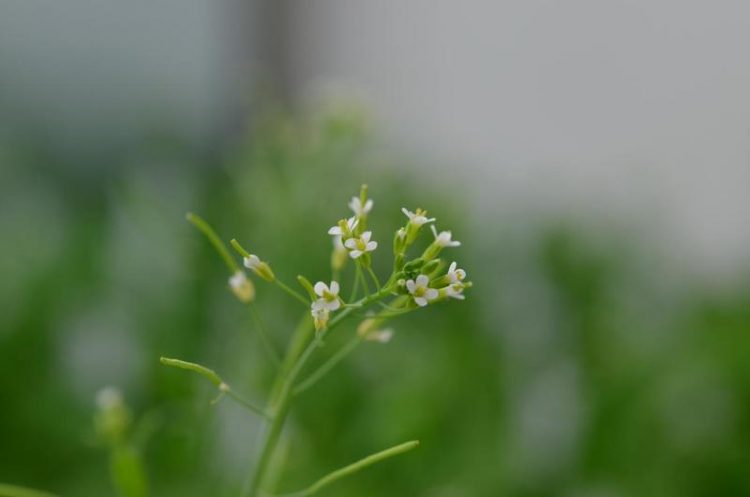Outwitting Climate Change with a Plant ‘Dimmer’?

For many plant species, such as the thale cress, there are now initiatives currently mapping the genome of many subspecies and varieties. Photo: Regnault/ TUM
Everyone knows that many plant species bloom at different times in spring. The time at which a plant blooms in spring does not follow the calendar, but is instead determined by environmental factors such as temperature and day length. Biologists have discovered that plants recognize these environmental factors via genetically determined programs and adapt their growth accordingly.
In order to adapt to new climate zones and to ensure the evolutionary success of the species, these genetic programs may be adapted over the course of evolution. These adaptive processes take place passively: Minor changes (mutations) take place in the genetic material (DNA sequence) of the genes involved. If an adaptation proves successful over the following years, a new population establishes itself as a genetically distinct subspecies.
Comparison of Biological Adaptations with Genetic Changes
In order to find out which mutations were used particularly frequently over the course of evolution, scientists compare biological adaptations such as shifts in the point in time at which blooming takes place with existing genetic changes.
For many plant species, such as the thale cress (Arabidopsis thaliana), which is often used in research, but also for food crops such as corn, rice, barley and wheat, there are now initiatives currently mapping the genome (entire DNA sequence) of many subspecies and varieties. This makes comparisons at the DNA level particularly simple and efficient.
In the journal “eLife”, Ulrich Lutz from the Chair of Plant Systems Biology at the TUM and his colleagues from the Helmholtz Zentrum München jointly describe the results of a comparative sequence analysis of the FLM (FLOW-ERING LOCUS M) gene from over a thousand Arabidopsis genome sequences.
FLM binds directly to DNA, allowing it to influence the creation of other genes (transcription), which delays bloom-ing. Via comparisons of the FLM DNA sequence from over a thousand subspecies, Lutz was able to determine which genetic changes occurred frequently as this plant evolved: Generally speaking, these are the changes that provide the plant with an adaptive advantage found in a large number of subspecies. Mutations that did not pro-vide an advantage, on the other hand, were lost over time. The frequency of the changes is therefore an indication that these mutations were the most successful from an evolutionary point of view.
For the FLM gene he characterized, Lutz was able to demonstrate that the genetic changes that occur worldwide have an influence on how frequently and efficiently the FLM gene is read. As FLM is able to delay the point in time at which blooming occurs, a more intensive reading of the gene directly corresponds to later blooming. FLM be-haves much like a light dimmer that the plant uses to regulate gene activity — and hence blooming — on a continuous scale.
FLM Gene Acts Like a Controller
The underlying gene changes influenced this reading of FLM. Modified DNA was found in the area of the gene ‘switch’ (promoter), which regulates how much of the FLM gene is produced. In addition, the mechanism of gene splicing could also be observed: As part of this process, parts are cut out of the interim gene product. The quantity of active FLM can also be adapted via genetic changes that impact gene splicing. Hence, a direct dependency was found between the point in time of blooming and the quantity of the FLM gene, which in Arabidopsis can be finely adjusted via DNA sequence changes.
“The FLM variants we identified are ideal candidate genes that thale cress can use to adapt the point in time at which blooming takes place to the temperature changes caused by climate change,” said Professor Claus Schwechheimer from the Chair of Plant Systems Biology at TUM.
Findings May Help Plants Adapt to Climate Change
Temperature changes of just a few degrees Celsius during the growth phase of crop plants such as canola or sugar beets have a negative impact on agricultural production. In the future, the findings obtained by the team including the TUM scientists may allow the FLM gene to be used as a regulator to help adapt the blooming period to different temperatures as a result of climate change. With this knowledge, the goal of efficient food production over the long term is now within reach.
Publication:
Ulrich Lutz, Thomas Nussbaumer, Manuel Spannagl, Julia Diener, Klaus F.X. Mayer, Claus Schwechheimer: Natural haplotypes of FLM non-coding sequences fine-tune flowering time in ambient spring temperatures in Arabidopsis, eLife 3/2017. DOI: 10.7554/eLife.22114
Contact:
Technical University of Munich
Chair of Plant Systems Biology
Prof. Dr. Claus Schwechheimer
Tel: +49 (0)8161 71-2880
E-Mail: claus.schwechheimer@wzw.tum.de
http://www.sysbiol.wzw.tum.de
https://www.tum.de/en/about-tum/news/press-releases/detail/article/33807/
Media Contact
All latest news from the category: Life Sciences and Chemistry
Articles and reports from the Life Sciences and chemistry area deal with applied and basic research into modern biology, chemistry and human medicine.
Valuable information can be found on a range of life sciences fields including bacteriology, biochemistry, bionics, bioinformatics, biophysics, biotechnology, genetics, geobotany, human biology, marine biology, microbiology, molecular biology, cellular biology, zoology, bioinorganic chemistry, microchemistry and environmental chemistry.
Newest articles

Silicon Carbide Innovation Alliance to drive industrial-scale semiconductor work
Known for its ability to withstand extreme environments and high voltages, silicon carbide (SiC) is a semiconducting material made up of silicon and carbon atoms arranged into crystals that is…

New SPECT/CT technique shows impressive biomarker identification
…offers increased access for prostate cancer patients. A novel SPECT/CT acquisition method can accurately detect radiopharmaceutical biodistribution in a convenient manner for prostate cancer patients, opening the door for more…

How 3D printers can give robots a soft touch
Soft skin coverings and touch sensors have emerged as a promising feature for robots that are both safer and more intuitive for human interaction, but they are expensive and difficult…





















